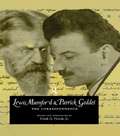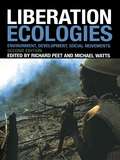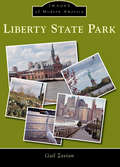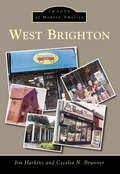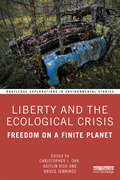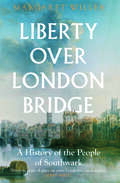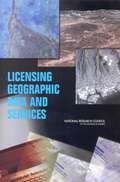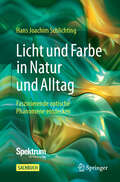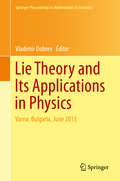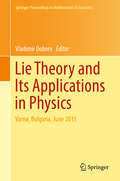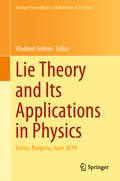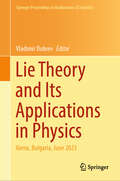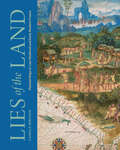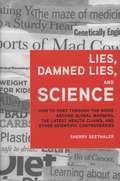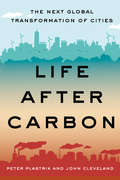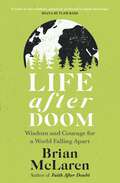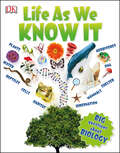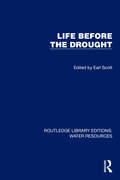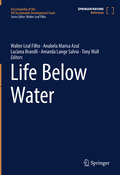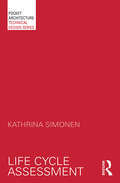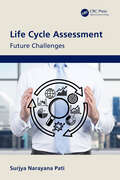- Table View
- List View
Lewis Mumford and Patrick Geddes: The Correspondence
by Frank G. NovakFirst published in 1995. Routledge is an imprint of Taylor & Francis, an informa company.
Liberalism and the Challenge of Climate Change
by Christopher ShawIn this book Christopher Shaw analyses how liberalism has shaped our understanding of climate change and how liberalism is legitimated in the face of a crisis for which liberalism has no answers.The language and symbolism we use to make sense of climate change arose in the post-World War II liberal institutions of the West. This language and symbolism, in neutralising the philosophical and ideological challenge climate change poses to the legitimacy of free market liberalism, has also closed off the possibility of imagining a different kind of future for humanity. The book is structured around a repurposing of the ‘guardrail’ concept, commonly used in climate science narratives to communicate the boundary between safe and dangerous climate change. Five discursive ‘guardrails’ are identified, which define a boundary between safe and dangerous ideas about how to respond to climate change. The theoretical treatment of these issues is complemented with data from interviews with opinion-formers, decision-makers and campaigners, exploring what models of human nature and political possibilities guide their approach to the politics of climate change governance.This book will be of great interest to students and scholars of climate change, liberal politics, environmental communication and environmental politics and philosophy, in general.
Liberation Ecologies: Environment, Development and Social Movements
by Richard Peet Michael WattsLiberation Ecologies brings together some of the most exciting theorists in the field to explore the impact of political ecology in today's developing world. The book casts new light on the crucial interrelations of development, social movements and the environment in the South - the 'bigger' half of our planet - and raises questions and hopes about change on the global scale. The in-depth case material is drawn from across the Developing World, from Latin America, Africa and Asia. The issues raised in contemporary political, economic and social theory are illustrated through these case studies. Ultimately, Liberation Ecologies questions what we understand by 'development', be it mainstream or alternative, and seeks to renew our sense of nature's range of possibilities.
Liberty State Park (Images of Modern America)
by Gail ZavianSituated on the Hudson River, the Central Railroad of New Jersey terminal operated its railroad/maritime complex for over 100 years in this area. After its shutdown in 1967, community advocates, already lobbying for nine years, continued their successful campaign for the site to become a public park. With over 1,000 acres, Liberty State Park opened on Flag Day--June 14, 1976. Today, this recreational landscape features the Nature Interpretive Center, Liberty Science Center, and a section of the Hudson River Waterfront Walkway. Liberty State Park, in Jersey City, is the only place in New Jersey where one can board a ferry to visit Ellis Island and the Statue of Liberty. Liberty State Park showcases the rich cultural and environmental history of this landscape's transformation from an abandoned waterfront transportation hub into one of America's most exceptional state parks.
Liberty State Park (Images of Modern America)
by Gail ZavianSituated on the Hudson River, the Central Railroad of New Jersey terminal operated its railroad/maritime complex for over 100 years in this area. After its shutdown in 1967, community advocates, already lobbying for nine years, continued their successful campaign for the site to become a public park. With over 1,000 acres, Liberty State Park opened on Flag Day--June 14, 1976. Today, this recreational landscape features the Nature Interpretive Center, Liberty Science Center, and a section of the Hudson River Waterfront Walkway. Liberty State Park, in Jersey City, is the only place in New Jersey where one can board a ferry to visit Ellis Island and the Statue of Liberty. Liberty State Park showcases the rich cultural and environmental history of this landscape's transformation from an abandoned waterfront transportation hub into one of America's most exceptional state parks.
Liberty and the Ecological Crisis: Freedom on a Finite Planet (Routledge Explorations in Environmental Studies #1)
by Bruce Jennings Christopher J. Orr Kaitlin KishThis book examines the concept of liberty in relation to civilization’s ability to live within ecological limits. Freedom, in all its renditions – choice, thought, action – has become inextricably linked to our understanding of what it means to be modern citizens. And yet, it is our relatively unbounded freedom that has resulted in so much ecological devastation. Liberty has piggy-backed on transformations in human–nature relationships that characterize the Anthropocene: increasing extraction of resources, industrialization, technological development, ecological destruction, and mass production linked to global consumerism. This volume provides a deeply critical examination of the concept of liberty as it relates to environmental politics and ethics in the long view. Contributions explore this entanglement of freedom and the ecological crisis, as well as investigate alternative modernities and more ecologically benign ways of living on Earth. The overarching framework for this collection is that liberty and agency need to be rethought before these strongly held ideals of our age are forced out. On a finite planet, our choices will become limited if we hope to survive the climatic transitions set in motion by uncontrolled consumption of resources and energy over the past 150 years. This volume suggests concrete political and philosophical approaches and governance strategies for learning how to flourish in new ways within the ecological constraints of the planet. Mapping out new ways forward for long-term ecological well-being, this book is essential reading for students and scholars of ecology, environmental ethics, politics, and sociology, and for the wider audience interested in the human–Earth relationship and global sustainability.
Liberty over London Bridge: A History of the People of Southwark
by Margaret WillesThe first complete history of Southwark, London&’s stubbornly independent community over the Thames Southwark&’s fortunes have always been tied to those of the City of London across the river. But from its founding in Roman times through to flourishing in the medieval era, the Borough has always fiercely asserted its independence. A place of licence, largely free of the City&’s jurisdiction, Southwark became a constant thorn in London&’s side: an administrative anachronism, a commercial rival, and an asylum for undesirable industries and residents. In this remarkable history of London&’s liberty beyond the bridge, Margaret Willes narrates the life and times of the people of Southwark, capturing the Borough&’s anarchic spirit of revelry. Populated by a potent mix of talented immigrants, religious dissenters, theatrical folk, brewers, and sex workers, Southwark often escaped urban jurisdiction—giving it an atmosphere of danger, misrule, and artistic freedom. Tracing Southwark&’s history from its Roman foundation to its present popularity as a place to visit, through Chaucer, to Shakespeare, and on to Dickens, Willes offers an indispensable exploration of the City&’s unacknowledged mirror image.
Licensing Geographic Data And Services
by Committee on Licensing Geographic Data ServicesGeographic data are used in all sectors of society to support a huge range of applications ranging from emergency response to land-use planning to location-based services. In the past, government agencies typically acquired ownership of such data from private-sector and other data producers and distributed these data without restriction. Licensing--whereby the producer may restrict redistribution--has emerged as an alternative business model that agencies must now consider among a suite of procurement options. The report highlights licensing perspectives and experiences of major stakeholder groups and examines the pros and cons of licensing. It concludes that licensing may be a viable option in some instances and advises agencies on how to best serve societal interests.
Licht und Farbe in Natur und Alltag: Faszinierende optische Phänomene entdecken
by Hans Joachim SchlichtingWir sind umgeben von faszinierenden optischen Phänomenen, die im Alltag meist unbemerkt bleiben. Doch was verbirgt sich hinter den strahlenförmigen Heiligenscheinen, die um den Schatten unseres Kopfes erscheinen, wenn wir in ein trübes Gewässer blicken? Haben Sie jemals die geheimnisvollen Lichtkreuze in Lichtkreisen wahrgenommen, die insbesondere am Morgen oder Abend an Häuserfronten zu sehen sind? Selbst verzerrte Mehrfachspiegelungen auf glänzenden Autokarosserien entgehen den meisten von uns. In diesem Sachbuch nehmen wir Sie mit auf eine Reise durch die Welt der verborgenen Lichterscheinungen. Entdecken Sie Phänomene wie die Quételetschen Ringe, die leuchtenden Glorien im Nebel oder die faszinierenden Strukturfarben von Spinnennetzen, die sich nur aus der passenden Perspektive offenbaren. Selbst bekannte Erscheinungen wie der Regenbogen, der eigene Schatten oder der Heiligenschein im feuchten Gras enthüllen bei genauer Betrachtung völlig neue Details und eröffnen ungeahnte Einsichten. Diese alltäglichen Phänomene werden ohne Formeln physikalisch beschrieben. Dabei erfährt vor allem die ästhetische und erlebnisorientierte Dimension durch reiche Bebilderung und Diktion eine besondere Wertschätzung.
Lie Theory and Its Applications in Physics
by Vladimir DobrevTraditionally, Lie Theory is a tool to build mathematical models for physical systems. Recently, the trend is towards geometrisation of the mathematical description of physical systems and objects. A geometric approach to a system yields in general some notion of symmetry which is very helpful in understanding its structure. Geometrisation and symmetries are meant in their broadest sense, i.e., classical geometry, differential geometry, groups and quantum groups, infinite-dimensional (super-)algebras, and their representations. Furthermore, we include the necessary tools from functional analysis and number theory. This is a large interdisciplinary and interrelated field. Samples of these new trends are presented in this volume, based on contributions from the Workshop "Lie Theory and Its Applications in Physics" held near Varna, Bulgaria, in June 2011. This book is suitable for an extensive audience of mathematicians, mathematical physicists, theoretical physicists, and researchers in the field of Lie Theory.
Lie Theory and Its Applications in Physics
by Vladimir DobrevTraditionally, Lie Theory is a tool to build mathematical models for physical systems. Recently, the trend is towards geometrisation of the mathematical description of physical systems and objects. A geometric approach to a system yields in general some notion of symmetry which is very helpful in understanding its structure. Geometrisation and symmetries are meant in their broadest sense, i. e. , classical geometry, differential geometry, groups and quantum groups, infinite-dimensional (super-)algebras, and their representations. Furthermore, we include the necessary tools from functional analysis and number theory. This is a large interdisciplinary and interrelated field. Samples of these new trends are presented in this volume, based on contributions from the Workshop "Lie Theory and Its Applications in Physics" held near Varna, Bulgaria, in June 2011. This book is suitable for an extensive audience of mathematicians, mathematical physicists, theoretical physicists, and researchers in the field of Lie Theory.
Lie Theory and Its Applications in Physics: Varna, Bulgaria, June 2019 (Springer Proceedings in Mathematics & Statistics #335)
by Vladimir DobrevThis volume presents modern trends in the area of symmetries and their applications based on contributions to the workshop "Lie Theory and Its Applications in Physics" held near Varna (Bulgaria) in June 2019. Traditionally, Lie theory is a tool to build mathematical models for physical systems. Recently, the trend is towards geometrization of the mathematical description of physical systems and objects. A geometric approach to a system yields in general some notion of symmetry, which is very helpful in understanding its structure. Geometrization and symmetries are meant in their widest sense, i.e., representation theory, algebraic geometry, number theory, infinite-dimensional Lie algebras and groups, superalgebras and supergroups, groups and quantum groups, noncommutative geometry, symmetries of linear and nonlinear partial differential operators, special functions, and others. Furthermore, the necessary tools from functional analysis are included. This is a large interdisciplinary and interrelated field. The topics covered in this volume from the workshop represent the most modern trends in the field : Representation Theory, Symmetries in String Theories, Symmetries in Gravity Theories, Supergravity, Conformal Field Theory, Integrable Systems, Polylogarithms, and Supersymmetry. They also include Supersymmetric Calogero-type models, Quantum Groups, Deformations, Quantum Computing and Deep Learning, Entanglement, Applications to Quantum Theory, and Exceptional Quantum Algebra for the standard model of particle physics This book is suitable for a broad audience of mathematicians, mathematical physicists, and theoretical physicists, including researchers and graduate students interested in Lie Theory.
Lie Theory and Its Applications in Physics: Varna, Bulgaria, June 2023 (Springer Proceedings in Mathematics & Statistics #473)
by Vladimir DobrevThis volume presents modern trends in the area of symmetries and their applications based on contributions to the workshop "Lie Theory and Its Applications in Physics" held in Sofia (Bulgaria) in June 2023. Traditionally, Lie theory is a tool to build mathematical models for physical systems. Recently, the trend is towards geometrization of the mathematical description of physical systems and objects. A geometric approach to a system yields in general some notion of symmetry, which is very helpful in understanding its structure. Geometrization and symmetries are meant in their widest sense, i.e., representation theory, algebraic geometry, number theory, infinite-dimensional Lie algebras and groups, superalgebras and supergroups, groups and quantum groups, noncommutative geometry, symmetries of linear and nonlinear partial differential operators, special functions, and others. Furthermore, the necessary tools from functional analysis are included. This is a large interdisciplinary and interrelated field. The topics covered in this volume from the workshop represent the most modern trends in the field: Representation Theory, Symmetries in String Theories, Symmetries in Gravity Theories, Supergravity, Conformal Field Theory, Integrable Systems, Polylogarithms, and Supersymmetry. They also include Supersymmetric Calogero-type models, Quantum Groups, Deformations, Quantum Computing and Deep Learning, Entanglement, Applications to Quantum Theory, and Exceptional Quantum Algebra for the standard model of particle physics This book is suitable for a broad audience of mathematicians, mathematical physicists, and theoretical physicists, including researchers and graduate students interested in Lie Theory.
Lieferkettensorgfaltspflichtengesetz: Ein Überblick für Praktiker
by Roland Falder Constantin Frank-Fahle Peter PoleacovDieses Buch ist eine der ersten Publikationen zum neuen Lieferkettensorgfaltspflichtengesetz. Der praxisbezogene Überblick stellt im Wesentlichen die neu geschaffenen Unternehmenspflichten, die Kernaspekte des Gesetzes sowie die Umsetzung der Sorgfaltspflichten dar. Zudem wird das neue Gesetz in den Kontext vergleichbarer Gesetze in anderen Jurisdiktionen und zur geplanten EU-Richtlinie gebracht, um einen internationalen Einblick in die Materie zu gewährleisten.
Lies of the Land: Painted Maps in Late Medieval and Early Modern France
by Camille SerchukLies of the Land examines the often-overlooked artistic roots of mapmaking practice in early modern France, offering an original perspective on discourses of accuracy and their relationship to the pictorial origins of modern mapmaking.Until the seventeenth century, most mapmakers in France were painters. Schooled in techniques of drawing and perspective—and in the careful study of nature that we associate with early modernity—they also learned the more expressive and imaginative Mannerist forms that dominated French painting in this period. Their maps draw on conventions of both painting and mapmaking to create beautiful, informative, and persuasive images for a wide variety of contexts and purposes. In this book, Camille Serchuk explores the strategies these cartographers deployed to weave together accuracy, ornament, and artifice in maps at all scales. Looking beyond the techniques of measurement and perspective, Serchuk shows how painterly interventions framed and manipulated the appearance and reception of cartographic objects.Lies of the Land is an important new assessment of the character and status of early modern cartography that challenges binary distinctions between art and science and between decorative and epistemic images. It will appeal especially to art historians and historians of sixteenth-century France as well as scholars of map history.
Lies, Damned Lies, and Science: How to Sort Through the Noise Around Global Warming, the Latest Health Claims, and Other Scientific Controversies
by Sherry SeethalerDon't get hoodwinked: make sense of news. . . and make smarter decisions for yourself, your family, and the world! Objective, balanced techniques for thinking about everything from diet and drugs to climate change. Identifying and getting past the biases of politicians, lobbyists, marketers. . . and even some scientific and medical professionals. By scientist Dr. Sherry Seethaler, one of the world's most respected and innovative science educators.
Life After Carbon: The Next Global Transformation of Cities
by John Cleveland Peter PlastrikIn Life After Carbon urban sustainability consultants Pete Plastrik and John Cleveland present a global pattern of reinvention from the stories of 25 "innovation lab" cities—from Copenhagento Melbourne. Plastrik and Cleveland show that four transformational ideas are driving urban climate innovation around the world: carbon-free advantage, efficient abundance, nature's benefits, and adaptive futures.Life After Carbon presents the new ideas that are replacing the pillars of the modern-city model, converting climate disaster into urban opportunity, and shaping the next transformation of cities worldwide. It will inspire anyone who cares about the future of our cities, and help them to map a sustainable pathforward.
Life After Doom: Wisdom and Courage for a World Falling Apart
by Brian D. MclarenWhat does faith look like when cynicism seems more plausible?What does hope look like when hope seems irrational?What does love look like when hate becomes more popular?In recent years, author and activist Brian McLaren has sensed a widespread emotional shift among growing numbers of people. More and more friends, colleagues, students, and readers confess their sense of futility, their feelings of frustration bordering on despair. They feel that human civilization has passed certain tipping points and that a tide of doom is inexorably rising. This feeling creates a deep inner divide, a tension between a sincere and hopeful commitment to action for the common good on the one hand, and on the other, a feeling that no actions can prevent the arrival of an undesirable or even dystopian future.Life After Doom is a sober analysis of how things stand in relation to climate breakdown, and a deeply insightful exploration of the challenge of living well, maintaining resilience and growing in wisdom and love in the face of nations, ecosystems, economies, religions, and other institutions in disarray. Brian McLaren is the author of Faith After Doubt and Do I Stay Christian? and is a leading and authoritative voice at the intersection of religious faith and contemporary culture.'A book of rare wisdom, genuinely profound in depth and scope'DIANA BUTLER BASS
Life After Whale: The Amazing Ecosystem of a Whale Fall
by Lynn BrunelleFollow a blue whale&’s enormous body to the bottom of the ocean, where it sets the stage for a bustling new ecosystem to flourish.All living things must one day die, and Earth&’s largest creature, the majestic blue whale, is no exception. But in nature, death is never a true ending. When this whale closes her eyes for the last time in her 90-year life, a process known as whale fall is just beginning. Her body will float to the surface, then slowly sink through the deep; from inflated behemoth to clean-picked skeleton, it will offer food and shelter at each stage to a vast diversity of organisms, over the course of a century and beyond. Caldecott Medalist Jason Chin&’s astonishing artwork enriches and amplifies engaging, well-researched text by Bill Nye the Science Guy writer Lynn Brunelle. Young lovers of the macabre will relish each page of Life After Whale. Meanwhile, those grappling with the hard subject of death will take solace in this honest look at the circle of life, which closes on a young whale enjoying the same waves as her ancestor. Additional back pages offer further info and reading recommendations on whales, whale falls, and ecosystems.A Junior Library Guild Gold Standard Selection
Life As We Know It (Big Questions)
by DKAs far as we know, Earth is the only inhabited planet in the Universe. So what makes Earth such an ideal place for life to survive? And how did it all get started? Life as We Know It goes back to the beginnings of life on our planet, explaining to middle grade readers how it emerged under hostile conditions from a chemical soup as a simple self-contained unit: the cell. Key biological themes, such as how cells work, produce energy, and reproduce are explained in simple terms. This knowledge is then used to explain how more complex organisms live. The book also looks at the wide variety of plant and animal life on Earth and how it evolved, and introduces the features and characteristics of members of the six kingdoms of life. Young readers will learn how life forms have adapted to occupy particular niches and what can happen if something upsets this balance. Lavishly illustrated with images from DK's extensive natural history photo library, this encyclopedia is a visual feast as well as a thorough treatment of biology. Through DK's unique visual style, scientific ideas that might appear intimidating in a textbook are made lucid at a glance.
Life Before the Drought (Routledge Library Editions: Water Resources)
by Earl ScottLittle attention had been paid to the realities of life in the Savanna-Sahel of West Africa before the drought of 1968-74, but this book, originally published in 1984 provides a set of authoritative accounts of the way in which the inhabitants cope with what outsiders perceive as a harsh environment. The peoples of the Savanna-Sahel are shown to be developers of strategies and technologies to manage their resources. Their understanding of the environment enables them to contribute substantially to any plans for economic and ecological recovery in the region. Their cooperative modes of life lead to greater social complexity and capacity for survival. Geographers, anthropologists and social historians should find the interdisciplinary human ecological approach of the book appealing. Development economists and rural planners will find the chapters on land-use patterns, and resource use particularly valuable.
Life Below Water (Encyclopedia of the UN Sustainable Development Goals)
by Walter Leal Filho Tony Wall Luciana Brandli Anabela Marisa Azul Amanda Lange SalviaThe problems related to the process of industrialisation such as biodiversity depletion, climate change and a worsening of health and living conditions, especially but not only in developing countries, intensify. Therefore, there is an increasing need to search for integrated solutions to make development more sustainable. The United Nations has acknowledged the problem and approved the “2030 Agenda for Sustainable Development”. On 1st January 2016, the 17 Sustainable Development Goals (SDGs) of the Agenda officially came into force. These goals cover the three dimensions of sustainable development: economic growth, social inclusion and environmental protection. The Encyclopedia of the UN Sustainable Development Goals comprehensively addresses the SDGs in an integrated way. It encompasses 17 volumes, each one devoted to one of the 17 SDGs. This volume is dedicated to SDG 14 “Conserve and sustainably use the oceans, seas and marine resources for sustainable development". Marine and coastal bio-resources, play an essential role in human well-being and social and economic development. This volume addresses this sustainability challenge providing the description of a range of terms, which allows a better understanding and fosters knowledge about it.Concretely, the defined targets are:Prevent and significantly reduce marine pollution of all kinds, in particular from land-based activities, including marine debris and nutrient pollutionSustainably manage and protect marine and coastal ecosystems to avoid significant adverse impacts, including by strengthening their resilience, and take action for their restoration in order to achieve healthy and productive oceansMinimize and address the impacts of ocean acidification, including through enhanced scientific cooperation at all levelsEffectively regulate harvesting and end overfishing, illegal, unreported and unregulated fishing and destructive fishing practices and implement science-based management plans, in order to restore fish stocks in the shortest time feasible, at least to levels that can produce maximum sustainable yield as determined by their biological characteristicsConserve at least 10 per cent of coastal and marine areas, consistent with national and international law and based on the best available scientific informationProhibit certain forms of fisheries subsidies which contribute to overcapacity and overfishing, eliminate subsidies that contribute to illegal, unreported and unregulated fishing and refrain from introducing new such subsidies, recognizing that appropriate and effective special and differential treatment for developing and least developed countries should be an integral part of the World Trade Organization fisheries subsidies negotiation 16Increase the economic benefits to small island developing states and least developed countries from the sustainable use of marine resources, including through sustainable management of fisheries, aquaculture and tourism Increase scientific knowledge, develop research capacity and transfer marine technology, taking into account the Intergovernmental Oceanographic Commission Criteria and Guidelines on the Transfer of Marine Technology, in order to improve ocean health and to enhance the contribution of marine biodiversity to the development of developing countries, in particular small island developing states and least developed countriesProvide access for small-scale artisanal fishers to marine resources and marketsEnhance the conservation and sustainable use of oceans and their resources by implementing international law as reflected in the United Nations Convention on the Law of the Sea, which provides the legal framework for the conservation and sustainable use of oceans and their resources, as recalled in paragraph 158 of “The future we want”Editorial Board</di
Life Cycle Analysis Based on Nanoparticles Applied to the Construction Industry: A Comprehensive Curriculum
by Pilar Mercader-Moyano Paula Porras-PereiraThis open access book describes in the recent years, there has been a notable upsurge in the use of nanomaterials, particularly within the construction and building sectors. The incorporation of nanoparticles introduces noteworthy changes in the physico-mechanical and physical–chemical characteristics of construction materials. Despite the acknowledged advantages of employing nanomaterials, uncertainties persist regarding their widespread adoption in development and applications, especially concerning potential environmental and human health implications. A crucial aspect in thoroughly assessing the environmental impacts of nanoproducts is the imperative quantification of effects on ecosystems and human health throughout the entire life cycle of these products. The indispensable utilization of a comprehensive tool, such as Life Cycle Assessment, becomes paramount in gaining a nuanced understanding of potential environmental and health challenges, thereby ensuring the environmental sustainability of nanomaterials. This academic publication endeavours to provide nanoproduct manufacturers, construction industry professionals, and waste managers with the necessary knowledge to comprehend the environmental and health impacts associated with the manufacturing, application, and disposal processes of nanoproducts used in the construction industry. This contribution aims to enhance their personal and professional development, consequently bolstering their employability at the European level. A thorough comprehension of potential releases throughout the entire life cycle of nanoproducts and their potential effects is imperative for ensuring the safe and sustainable utilization of these innovative materials. The application of life cycle thinking emerges as a pivotal component in appropriately evaluating the potential impacts associated with nanomaterial releases.
Life Cycle Assessment (PocketArchitecture)
by Kathrina SimonenLife Cycle Assessment addresses the dynamic and dialectic of building and ecology, presenting the key theories and techniques surrounding the use of life cycle assessment data and methods. Architects and construction professionals must assume greater responsibility in helping building owners to understand the implications of making material, manufacturing, and assemblage decisions and therefore design to accommodate more ecological building. Life Cycle Assessment is a guide for architects, engineers, and builders, presenting the principles and art of performing life cycle impact assessments of materials and whole buildings, including the need to define meaningful goals and objectives and critically evaluate analysis assumptions. As part of the PocketArchitecture Series, the book includes both fundamentals and advanced topics. The book is primarily focused on arming the design and construction professional with the tools necessary to make design decisions regarding life cycle, reuse, and sustainability. As such, the book is a practical text on the concepts and applications of life cycle techniques and environmental impact evaluation in architecture and is presented in language and depth appropriate for building industry professionals.
Life Cycle Assessment: Future Challenges
by Surjya Narayana PatiThis book offers an itemized analysis of Life Cycle Assessment (LCA), for use in any processes, products, services, industries, organizations and so forth. Various challenges faced during applications of LCA, and its extension are discussed including their benefits. Further, the book provides practical examples of LCA in different core sectors, such as cement and construction. Each chapter functions as a stand-alone unit within the book and defines its individual role within the overall concept of LCA. Features: Covers Life Cycle Assessment (LCA) and future challenges including its practical applications as climate change tool. Connects life cycle management and LCA/environmental management. Explains benefits of LCA studies for both internal and external purpose in terms of various impact parameters. Identifies different raw materials or alternate energy mediums for changing inputs to reduce environmental impacts. Discusses extension of LCA concept like LCC, LCSA, SCLA, and OLCA. This book is aimed at professionals in all engineering areas and environmental studies.
